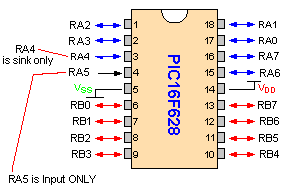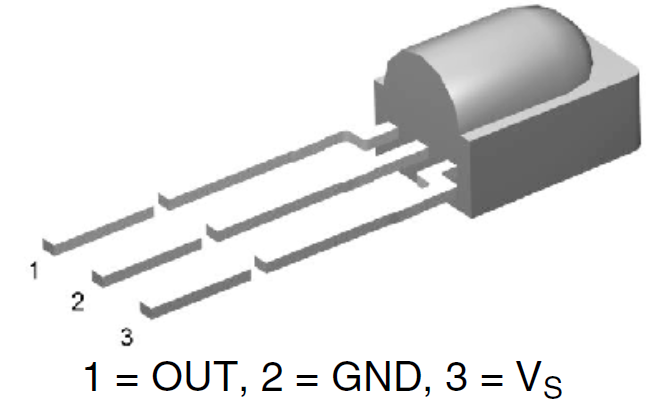COSC 422/COSC 524 - Introduction to Microprocessors
Winter 2020
ID 24718/24720
PH 503 10:00-11:50am
Instructor: Dr. William Sverdlik
Office: 512 Something_or_other
Pray-Harrold
Office Hours:
(tentative)
MW 9:00-9:50,
MW 12:00-2:00,
W 4:30-5:30
Phone: 734-487-7081
e-mail:
wsverdlik@emich.edu
Meeting Times: MW 503PH 10:00-11:50am
Textbook: No book to buy!! All material will be available from the
Internet.
Hardware: There is hardware to
purchase. I have already emailed you about purchasing about $12 worth of electrical
items from Amazon.
Additionally, you will need to purchase a robotics kit from Tinkertech.
This is a Maker's Space on MIchigan Ave. in Yp[silanti. We will be spending
some time there.
The TinkerTech robot will cost you about $90. The $90 plus your lab fee
will also get you a one month membership at the Maker's Space and will
also include training and
check-out on the laser cutter.
Format:
There
will be one examination (Monday March 16) (changed to Wednesday March 18) a major programming
project (broken up into smaller parts), and some "extra" work, plus
surprise quizzes.
- Examination:
are open book, open notes. It is worth 100 points.
- Quizzes (announced)
Jan 27 and Feb. 17 . Open book and worth 50 points each
- Quizzes
(unannounced) , and assorted assignments: Probably about 5.
Each worth 5 points. Here's a
hint: if I say "try this", "do this", or "figure this out", there is a
good chance I will quiz you on it.
- Programming
Assignments:
There will be 7 programming assignments. These are generally
cumulative, that is, you must complete one before proceeding as they
build upon each other. The firat 5 assignments are "solo" projects, the
last 2 are team projects.
The end result is a remote controlled robot. Each programming assignment is
worth 25 points.
The assignments (given in more detail below):
1) Flash an LED at 38 khz
2) Flash an LED on/off at 38khz for 1 millisecond intervals
3) Bit bash 3 bits. Hardwired processor to processor
4) Bit bash 3 bits with IR LED and IR receiver. Interrupt driven receiver.
5) Bit bash 3 bits. Transmitter uses keypad
6) Move robot forward for 2 feet, turn left, go forward 2 feet, turn right,
go reverse 2 feet
7) Remote controlled robot (combine programs 5 and 6)
Extra Stuff : (probably working alone) from
time to time, I may approach you and give you some unknown piece
of electronics. You will be given approximately 1 week to explain and
demo this to class.
Final Exam : Monday April 27
9:30-11:00. Comprehensive . 100 points
Total points=500
Approximate Grading Scale:
450-500 A
400-450 B
325-400 C
250-325 D
<250 E
Important Dates This Semester
Jan. 6 - classes begin
Jan 20 - MLK Day (no classes)
Feb 24 - March 1 Winter Recess (no class)
March 11 - March 19 (changed! March 16-19) Bill is not here ( But Fear NOT! You will have
class, including lectures and an exam)
April 20 - Last Day of Classes
April 27 - Your Final Exam
Cheating: It violates University policy, you know....so
don't do it. Cheating is defined as representing all or part of
someones elses work as your own. While you are certainly encouraged
to seek the advice of others in this class on assignments, the work
you hand in should represent your own efforts. Violation of this rule
will be dealt with according to University policy. If you are really
stuck on a problem, come see the instructor!
What will happen in this class:
You will build and program a remote controlled robot. You will
need to build both the robot and the remote control. Both require
programming.
REFERENCES (I keep these open whenever
I'm programming)
Skeleton
Program (please note: all programs need to follow this format. In fact,
you should **copy** this to start all programs)
Instruction
Set References and defined constants
Full
Instruction Set Reference
Data
Sheet for PIC 16F62X
SOFTWARE
Burner Software
MPLAB IDE - GUI
for programming chip (new version)
Older
versions of MPLAB (scroll down to MPLAB IDE archives. I like
versions in the 8's)
Parallax
Propscope download
Parallax
Oscilliscope download
Helpful (???) Videos
A Simple Introduction to Breadboards
MPLAB X IDE (the newer version of
MPLAB) - how to generate a hex file from source
Video on Timing Loops (uploaded
January 19,2017 length: 26:54)
Source
code to go with video
Programming Assignment #1 (Due: Wednesday January 22)- Flash
an LED at 38kHz
Programming Assignment #2 (Due: Wednesday January 29)- Flash
LED at 38kHz for 1 millisecond, off for 1 millisecond
Homework
1 (not to hand in, but I will assume you know this)
Homework 2 (not to hand in, but.....you
know the rest)
Programming Assignment #3 (Due: Wednesday February 12) - Bit Banging
Homework 3 ( another quiz coming soon)
Sample I/O using Interrupts
Using the membrane keypad (you need this for project 4)
Programming Assignment #4 (Due: Wednesday March 4). Here's the
assignment: redo assignment number 3 but use the IR LED and IR receiver
I provided to you. This assigment MUST use interrupts. Specifically, on
the receiver side, the IR receiver signal pin should be connected to
pin B0. Recall, with no flashing LED this signal is HIGH. So an
interrupt should occur on a HIGH-TO-LOW transition (that is to say,
when the IR starts flashing).
Programming Assignment #5 (Due: Wednesday March 25). Here's the assignment: redo assignment number 4 but use a membrane keypad
that I will provide. Since you are transmitting 3 bits, the keys 0 thru 7 should be valid for transmisssion.
Assignment #6 (to be completed before your exam on March 16): watch video and do problems!
Some references forTimer0:
Timer0 reference 1
Timer 0 reference 2 (Microchip tutorial 1 Timer0)
Timer 0 Reference 3 (Microchip tutorial 2 on Timer0 interrupts)
Programming Assignments for the Rest of the Semester
------------------Old Class Below. Everything above is new and OK!!
-----------------------------------------------
Programming Assignment #3 (Due Monday February 13) - Bit
Banging
Programming Assignment #4 (Due Wednesday February 15) - Remote control
robot !! Work in pairs. Robot
normally moves forward. When it detects 38kHz infrared
LED, it stops. Remoce the LED and it
moves again
Wednesday March 1 and Monday March 6 - Presentations of interrupts and
timers
Programming Assignment #5 (Due: March 22,2017) Robot programming :
a) Motor Control (Pulse
Width Modulation) is controlled via timer interrupts. Timer is set to
"low"
time (20 milliseconds) and
interrupt handler pulses motors high
b) An external sensor, for
now we use the robot antennaes, is hardwired to an interrupt line (line
B0) and handled when
triggered. Normally, the robot moves forward (see part a). When the
antennaes are "triggered", the robot should move in reverse for 2
seconds and turn either left or right 30%. Then the normal program
should take over (move forward).
Exam! Yes, we need to have one. Do you know the basic commands ? Can
you poll a line, Can you write a timer loop ? We will have an
examination on Wednesday March 29. You may bring nay printed material
you like for reference; no computer access permitted.
Programming Assignment #6 (Wednesday April 10, 2017) - mystery sensor
?????
Links:
Powerpoint
USART
Transmitter
USART
Receiver
USART
doc
Sample
timer code
Harvard
Architecture (wikipedia)
PICs!!!!
Microchip - home of
the PIC
Data
Sheet for the PIC 16F627/8
PIC
Training Videos!! Homework - watch them now!!
My
Notes on Video 1
Tutorials:
Some
quick and dirty assembler issues
Nigel's
Page
Sample Code
Skeleton
Program
Language
Tutorial
IO
Example 1
IO
Example with interrupts
Using FSR
and INDF
Watch
Dog Timer (WDT)
Timed
Delays
Seven Segment Display Documentation
Seven
Segment Display Code
Code (c code) for reading an ADC0831 A/D converter
Pulse
Width Modulation (PWM) and Servo Motors
Analog/Digital
(A/D) Conversion and Serial Peripheral Interface (SPI)
Other Topics:
SPI
- Serial Peripheral Interface (wikipedia)
II-C
Protocol (I squared C)
The following is from an old class.
Just use it as a reference; we'll update as the class progresses
What to do (this is informal at this point)
Week 1 - watch all the PIC Training Videos
To Do; some
elementary electronics
Week 2 - start reading the tutorials. You should
read thru the first 7 lessons of "You should work thru this one"
To Do: how to use
programmer, oscilliscope,
Week 3 - finish up the rest of the tutorials and start
reading Nigel's Page tutorials
To Do: analyze
timing loops
Week 4 - serial communication, bit bashing
Week 5 - A/D conversion, Serial Peripheral Interface(SPI)
Week 6 - Pulse Width Modulation (PWM)
Week 7 - Interrupts
Week 8 - putting it all together - PWM, SPI, A/D
Tentative Dates (Winter 2014 - dates good
up to 4/14/2014) :
Wednesday Januray 29, 2014 - Homework
1 due
Wednesday February 5, 2014 - Program
1 due (flash and LED)
Wednesday February 17, 2014 - Program
2 due (7 segment LED and bit bashing)
Wednesday March 5, 2014 - Midterm Exam . Study Guide here
and here
.
Monday March 10, 2014 - Program
3 (the dancing robot)
Final
Project - Initial Ideas (nothing to do yet, but start thinking)
Wednesday March 13, 2014 - One page write up and presentation of your final
project idea
Graduate
Student Presentations
March 31 - Grad Student Presentation 1
April 2 - Grad Student Presentation 2
April 7 - Grad Student Presentation 3
April 14 - Exam 2
-----------------------------------------------------------------------------------



